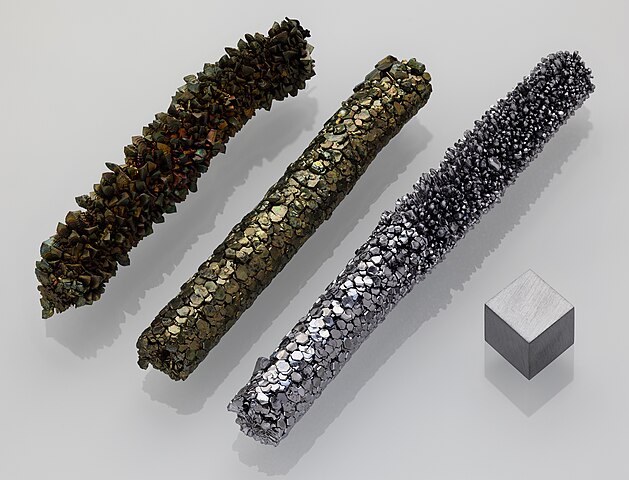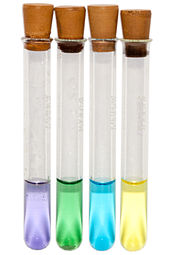Vanadium is an element with the symbol V and atomic number 23. It is a hard, silvery-grey, malleable transition metal. The elemental metal is rarely found in nature.
Spanish-Mexican scientist Andrés Manuel del Río discovered compounds of vanadium in 1801 by analyzing a new lead-bearing mineral. Then in 1830, Nils Gabriel Sefström generated chlorides of vanadium, thus proving there was a new element, and named it “vanadium” after the Scandinavian goddess of beauty and fertility, Vanadís. The name was based on the wide range of colors found in vanadium compounds.
Del Rio's lead mineral was eventually called vanadinite for its vanadium content. In 1867 Henry Enfield Roscoe obtained the pure element.

Vanadium, crystal bar
Vanadium occurs naturally in about 65 minerals and fossil fuel deposits. It is mainly used to produce specialty steel alloys such as high-speed tool steels, and some aluminium alloys. The most important industrial vanadium compound, vanadium pentoxide, is used as a catalyst for the production of sulfuric acid.
Neither a Recommended Dietary Intake nor an Adequate Intake has been established. Dietary intake is estimated at 6 to 18 µg/day, with less than 5% absorbed. The Tolerable Upper Intake Level (UL) of dietary vanadium, beyond which adverse effects may occur, is set at 1.8 mg/day
Facts
The vanadium symbol is V
The atomic number of Vanadium is 23.
It is a hard, silvery-grey, malleable transition metal
Spanish-Mexican scientist Andrés Manuel del Río discovered compounds of vanadium in 1801
Vanadium is the 20th most abundant element in the earth's crust
It is named “vanadium” after the Scandinavian goddess of beauty and fertility, Vanadís
The name was based on the wide range of colors found in vanadium compounds
Del Rio's lead mineral was ultimately named vanadinite for its vanadium content.
In 1867 Henry Enfield Roscoe obtained pure Vanadium.
Vanadium occurs naturally in about 65 different minerals.
Vanadium was almost renamed “rionium” after its original discoverer, but this proposal was rejected.
Vanadium is mined mostly in China, South Africa, and eastern Russia
These three countries mined more than 96% of the 100,000 tons of produced vanadium, with China providing 70%
In the universe, the cosmic abundance of vanadium is 0.0001%
Naturally occurring vanadium is composed of one stable isotope, 51V,
vanadium has one radioactive isotope, 50V.
50V has a half-life of 1.5×1017 years and a natural abundance of 0.25%
Twenty-four artificial radioisotopes have been characterized
The most stable isotope is 49V with a half-life of 330 days
vanadium is stable against alkalis and sulfuric and hydrochloric acids

The first large-scale use of vanadium was in the steel alloy chassis of the Ford Model T
At the start of the 20th century, most vanadium ore was mined by the American Vanadium Company in Peru
The oxide and some other salts of vanadium have moderate toxicity
Vanadium alloys are used to make nuclear reactors because of their low-neutron-absorbing properties.
Most vanadium is used as a steel alloy called ferrovanadium.
Vanadium can be combined with gallium to form superconductive magnets.
Vanadium is also present in bauxite and deposits of crude oil, coal, oil shale, and tar sands
Vanadium atoms have 23 electrons, 28 neutrons, and 23 protons.
Mixed with aluminium in titanium alloys, it is used in jet engines, high-speed airframes, and dental implants.
Vanadium increases the strength and temperature stability of titanium
Vanadium is more often found in oceanic animals than in land-based animals.
Vanadium pentoxide is used in ceramics and as a catalyst for the production of sulfuric acid.
The increase of strength in steel containing small amounts of vanadium was discovered in the early 20th century.
Vanadium can be used in the process of refining uranium for nuclear purposes.
Deficiencies in vanadium result in reduced growth in rats.
Vanadium can be found in trace amounts in many types of food, these include mushrooms, black pepper, parsley, shellfish, beer and grain.
All vanadium compounds should be considered toxic
In an aqueous solution, vanadium forms complexes of which the colors are lilac, green, blue, and yellow-orange oxides, the formula for which depends on pH.
Lithium vanadium oxide has been proposed for use as a high-energy-density anode for lithium-ion batteries
Vanadyl sulfate as a dietary supplement has been researched as a means of increasing insulin sensitivity or otherwise improving glycemic control in people who are diabetic
